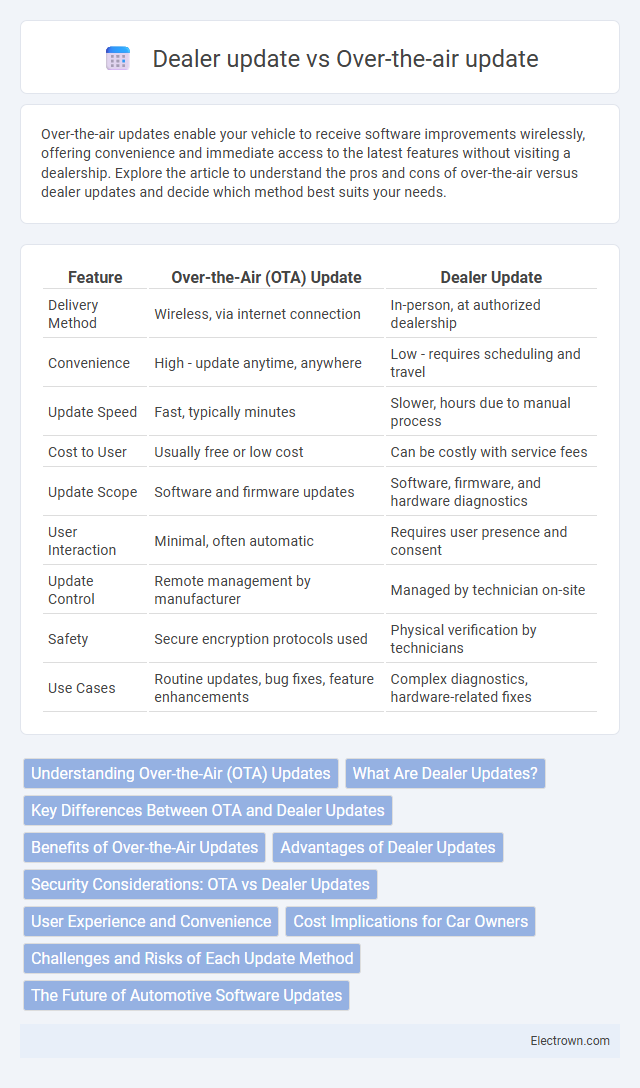Over-the-air updates enable your vehicle to receive software improvements wirelessly, offering convenience and immediate access to the latest features without visiting a dealership. Explore the article to understand the pros and cons of over-the-air versus dealer updates and decide which method best suits your needs.
Table of Comparison
| Feature | Over-the-Air (OTA) Update | Dealer Update |
|---|---|---|
| Delivery Method | Wireless, via internet connection | In-person, at authorized dealership |
| Convenience | High - update anytime, anywhere | Low - requires scheduling and travel |
| Update Speed | Fast, typically minutes | Slower, hours due to manual process |
| Cost to User | Usually free or low cost | Can be costly with service fees |
| Update Scope | Software and firmware updates | Software, firmware, and hardware diagnostics |
| User Interaction | Minimal, often automatic | Requires user presence and consent |
| Update Control | Remote management by manufacturer | Managed by technician on-site |
| Safety | Secure encryption protocols used | Physical verification by technicians |
| Use Cases | Routine updates, bug fixes, feature enhancements | Complex diagnostics, hardware-related fixes |
Understanding Over-the-Air (OTA) Updates
Over-the-Air (OTA) updates enable your vehicle's software to be upgraded wirelessly through a cellular or Wi-Fi connection, eliminating the need to visit a dealer. This method delivers timely enhancements, security patches, and new features directly to your car, ensuring convenience and minimal downtime. In contrast, dealer updates require scheduling service appointments, often causing delays and added expenses.
What Are Dealer Updates?
Dealer updates refer to software or firmware enhancements installed on vehicles during scheduled service appointments at authorized dealerships, often requiring physical connection or specialized diagnostic equipment. These updates ensure system calibration, safety improvements, and compatibility checks that may not be feasible via remote methods. Compared to over-the-air updates, dealer updates provide personalized technical support and validation by certified technicians, maintaining vehicle performance and reliability.
Key Differences Between OTA and Dealer Updates
Over-the-air (OTA) updates deliver software improvements directly to your vehicle via wireless connectivity, enabling convenience and instant access without visiting a dealership. Dealer updates require physical access to the service center, often involving manual installation by technicians, which can be time-consuming and less flexible. OTA updates optimize efficiency by providing faster deployment of enhancements, while dealer updates may offer deeper diagnostics or hardware-related modifications not possible remotely.
Benefits of Over-the-Air Updates
Over-the-air (OTA) updates enhance vehicle maintenance by delivering timely software upgrades directly to the car, reducing the need for in-person dealer visits and minimizing downtime for drivers. OTA updates improve vehicle security through rapid deployment of patches that address vulnerabilities without delays inherent in dealer scheduling. This method also lowers operational costs for manufacturers and provides a seamless user experience by enabling continuous improvements to infotainment, navigation, and autonomous driving features.
Advantages of Dealer Updates
Dealer updates provide expert diagnostics and personalized service, ensuring software installations are precisely calibrated to vehicle specifications. Technicians can identify and address potential hardware issues during the update process, enhancing overall vehicle reliability. This hands-on approach minimizes the risk of update errors and supports complex system integrations that over-the-air updates may not handle effectively.
Security Considerations: OTA vs Dealer Updates
Over-the-air (OTA) updates offer enhanced security by utilizing encrypted data transmission and automated authentication protocols, reducing the risk of human error compared to dealer updates. Dealer updates rely on physical access, which can introduce vulnerabilities through unsecured hardware or outdated software tools. Regularly updated security certificates and end-to-end encryption in OTA systems ensure timely patches against emerging threats, whereas dealer updates may delay critical security fixes due to scheduling and logistical constraints.
User Experience and Convenience
Over-the-air (OTA) updates enhance user experience by allowing your vehicle or device to receive software improvements remotely without visiting a dealer, saving time and effort. Dealer updates require scheduling appointments and physical presence, often causing delays and inconvenience. OTA updates provide seamless, timely enhancements, ensuring your system stays current while maximizing convenience.
Cost Implications for Car Owners
Over-the-air (OTA) updates significantly reduce costs for car owners by eliminating the need for dealership visits and labor charges associated with traditional dealer updates. OTA updates provide timely software enhancements directly via the internet, minimizing vehicle downtime and transportation expenses. In contrast, dealer updates often involve higher costs due to service fees, appointment scheduling, and potential travel to authorized service centers.
Challenges and Risks of Each Update Method
Over-the-air (OTA) updates face challenges such as connectivity issues, potential cybersecurity threats, and incomplete installations due to power interruptions, posing risks to your vehicle's software integrity. Dealer updates require scheduling and physical visits, increasing downtime and operational costs while risking delayed patches that may leave systems vulnerable. Both methods must balance convenience and security, but OTA updates demand robust cybersecurity protocols to mitigate remote attack risks effectively.
The Future of Automotive Software Updates
Over-the-air (OTA) updates enable automotive manufacturers to remotely deliver software improvements and security patches, dramatically reducing downtime compared to traditional dealer updates that require physical visits. OTA technology supports faster deployment of critical features and bug fixes, enhancing vehicle performance and customer experience while lowering operational costs. As vehicles become increasingly connected and reliant on software, OTA updates represent the future standard for maintaining and upgrading automotive systems efficiently and securely.
Over-the-air update vs Dealer update Infographic

 electrown.com
electrown.com